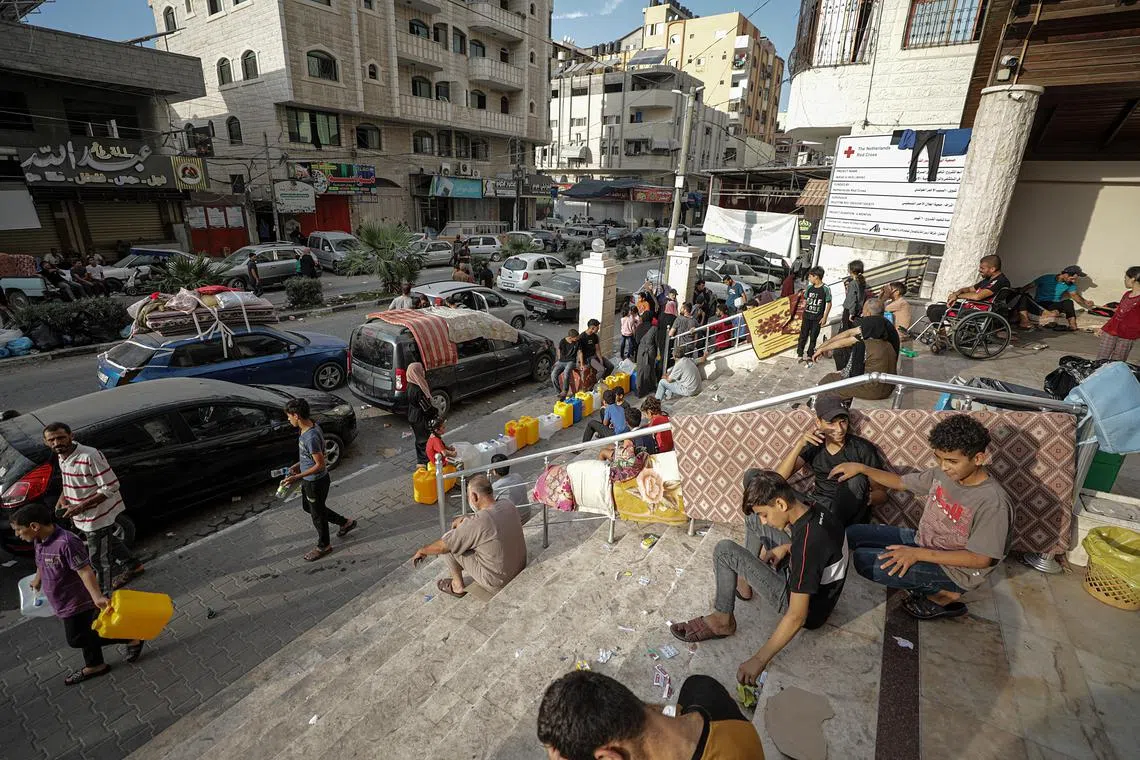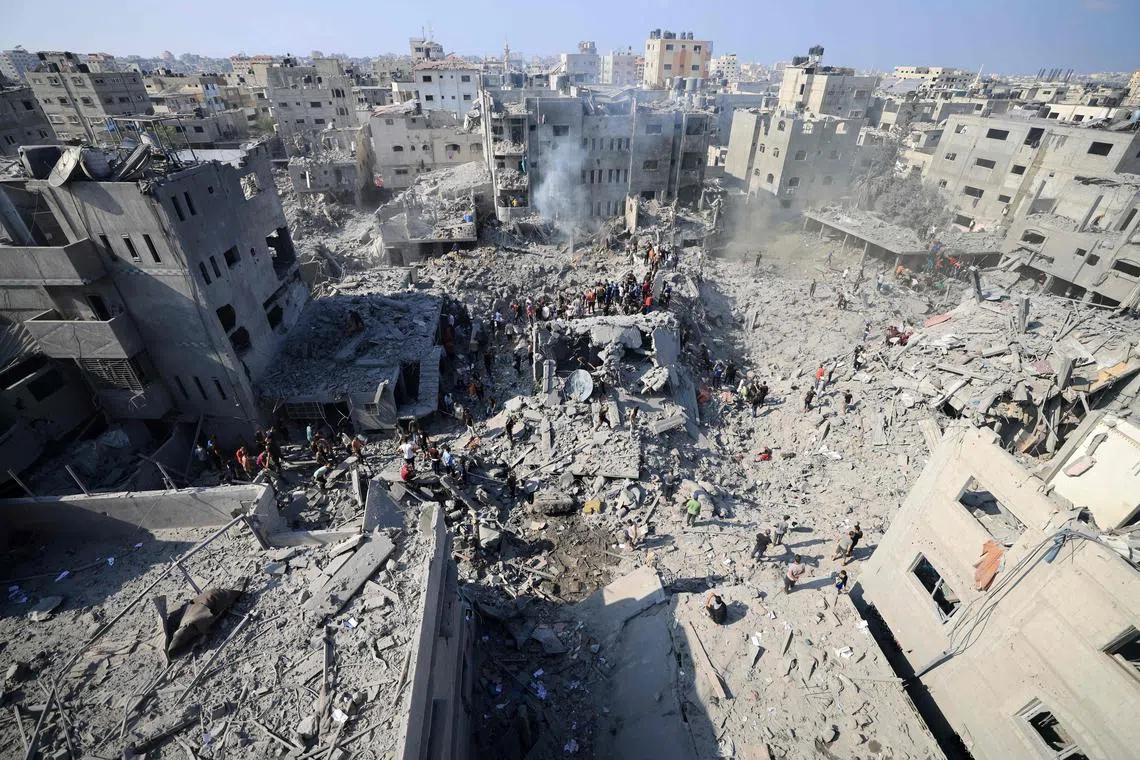Blinken urges Israel to take steps to avoid civilian casualties as Gaza death toll soars
Sign up now: Get ST's newsletters delivered to your inbox
Follow topic:
GAZA/JERUSALEM – United States Secretary of State Antony Blinken appealed to Israel on Friday to take steps to protect civilians in the Gaza Strip as its forces kept up their bombardment of the Palestinian enclave and the death toll among residents soared.
The Israeli military said its troops were fighting Hamas militants in close-quarters combat in the ruined streets after encircling Gaza City in their bid to wipe out the Islamist group that controls the small, densely populated territory.
Israeli forces also pounded Gaza from ground, sea and air throughout the night, amid rising global alarm over scarcities of necessities, collapsing medical services and a civilian death toll that has now surpassed 9,000.
Mr Blinken was visiting the region for the second time in less than a month to show support for Israel, a close US ally, over its response to the Oct 7 Hamas militant attack on southern Israeli communities that killed some 1,400 people and triggered the war.
Speaking before meeting Israeli President Isaac Herzog, Mr Blinken reiterated that Israel has a right to “do everything possible” to ensure that such an attack never happened again.
But he added: “It is very important when it comes to protection of civilians who are caught in the crossfire of Hamas’ making, that everything be done to protect them and to bring assistance to those who so desperately need it, who are not in any way responsible for what happened on Oct 7.”
Washington has dismissed calls from Arab and several other nations for a full ceasefire in the war – now in its 28th day – but wants more temporary and local pauses in fighting to allow aid to get into Gaza and for hostages taken by Hamas to leave.
Mr Blinken also spoke to Israeli Prime Minister Benjamin Netanyahu for almost an hour before both met members of Israel’s emergency Cabinet, formed after the Hamas assault.
The health authorities in Gaza say at least 9,227 people – many of them women and children – have been killed since Israel started its blitz on the enclave of 2.3 million people in retaliation for the Hamas rampage in southern Israel.
Israel says the Iran-backed Hamas killed 1,400 people, mostly civilians, and took more than 240 hostages in the deadliest day of its 75-year history.
Close-quarters combat
The Israeli military said its troops and tanks were encountering mines and booby traps as they advanced in Gaza. Hamas fighters were making use of a vast underground tunnel network to stage hit-and-run attacks.
It said Israeli warplanes and artillery and its navy struck Hamas targets overnight, killing several militants, including Mustafa Dalul, a Hamas commander who it said directed combat in Gaza.
Gaza City – traditionally a Hamas bastion – was surrounded, military spokesman Daniel Hagari said.
“The soldiers are advancing in battles, during which they are destroying terror infrastructure above ground and below ground and eliminating terrorists,” he told a briefing.
Another spokesman, Lieutenant-Colonel Richard Hecht, said they were in a complex urban battle. “It’s very, very close-quarters combat between our troops and Hamas operatives.”
Israel says it has lost 23 soldiers in the offensive.
Mr Abu Ubaida, spokesman for the armed wing of Hamas, said in a televised speech on Thursday that Israel’s death toll in Gaza was much higher than the military had announced.
“Your soldiers will return in black bags,” he said.
Hamas and its Islamic Jihad ally said their fighters detonated explosives against advancing troops, dropped grenades from drones, and fired mortars and anti-tank rockets in fierce urban warfare around destroyed buildings and heaps of rubble.
They were emerging from tunnels to fire at tanks, then disappearing back into the network, according to residents and videos from both groups.
In one Hamas military video, a fighter surfaces in a Gaza field and places an explosive device on a tank.
An explosion is audible as the fighter, who appears to be wearing a body camera to document the incident, sprints back to the tunnel and fires an anti-tank missile towards the tank.
The United Arab Emirates, one of a handful of Arab states with diplomatic ties to Israel, said on Friday it was working “relentlessly” for an immediate ceasefire, warning that the risk of regional spillover and further escalation was real.
Israel has dismissed these calls, saying it targets Hamas fighters whom it accuses of hiding among Gaza’s population and civilian buildings.
‘Between ice and fire’
The Rafah crossing from Gaza to Egypt was due to open for a third day on Friday for limited evacuations under a Qatari-brokered deal aimed at letting some foreign passport holders, their dependants and some wounded Gazans out of the enclave.
According to border officials, more than 700 foreign citizens left for Egypt via Rafah on the two previous days. Dozens of critically injured Palestinians were to cross too.
Ms Suzan Beseiso, a US citizen with relatives in Gaza, said she was not excited to leave Gaza “because we have so many people that we love and care about”.
“Right now I’m between ice and fire. I don’t know if I’m ever going to be able to see the family I left behind or the friends I left behind. People are dying. Everybody’s dying. Nobody’s safe.”
Israel also sent around 7,000 Palestinians who had been working in Israel and the West Bank before Oct 7 back to Gaza through the Kerem Shalom crossing in the south. Workers said they were detained and ill-treated by the Israeli authorities.
Rear-Admiral Hagari said Israel was also “highly prepared” on its northern border with Lebanon, where he said Iranian-backed militants were carrying out actions with the aim of diverting it from the war in Gaza.
‘Grave risk of genocide’
The United Nations rights office on Friday described the situation in the occupied West Bank as “alarming”, saying Israeli forces were increasingly using military tactics and weapons in law enforcement operations there.
UN experts said Palestinian civilians, who are suffering shortages of food, fuel, drinking water and medicine, are at “grave risk of genocide”.
“Water is being used as a weapon of war,” said Ms Juliette Touma, a spokeswoman for the UN agency for Palestinian refugees.
At least 132 Palestinians, including 41 children, were killed in the West Bank – 124 by Israeli forces and eight by Israeli settlers. Two Israeli soldiers were also killed.
Palestinians trapped in Gaza City hope that a truce can be reached soon.
“Does the world wait for hundreds of thousands who refuse to leave their homes, who have no guilt but that they don’t want to leave their country, to be massacred by Israel?“ said one.
‘We are getting sick’
In Khan Younis, nine-year-old Rafif Abu Ziyada said she was drinking dirty water and getting stomach pains and headaches.
“There is no cooking gas, there is no water, we don’t eat well. We are getting sick,” she said. “There’s garbage on the ground and the whole place is polluted.”
Over a third of Gaza’s 35 hospitals are not functioning, with many turned into impromptu refugee camps.

Palestinians who fled their homes gathering at the Al-Quds hospital following Israeli air strikes on the Tel al-Hawa neighbourhood in Gaza City.
PHOTO: EPA-EFE
US national security spokesman John Kirby said on Thursday that temporary, localised humanitarian pauses would not prevent Israel from defending itself.
“What we’re trying to do is explore the idea of as many pauses as might be necessary to continue to get aid out and to continue to work to get people out safely, including hostages,” he told reporters at a briefing.
The latest war in the decades-old conflict began when Hamas fighters broke through the border
In central Gaza, an air strike on Thursday destroyed clusters of houses in the Bureij refugee camp, residents and Gaza officials said, with 15 bodies pulled from the rubble.
“A massacre, a massacre,” people cried as they gathered corpses in blankets.

Buildings destroyed following an Israeli strike on the Bureij refugee camp in the central Gaza Strip on Nov 2.
PHOTO: AFP
Israel was talking to medical agencies about setting up field hospitals in the southern part of the Gaza Strip, an Israeli official said on Thursday.
Israel’s latest strikes have included the heavily populated area of Jabalia, set up as a refugee camp in 1948.
Gaza’s Hamas-run media office said at least 195 Palestinians were killed in two hits on Tuesday and Wednesday, with 120 missing and at least 777 people hurt. REUTERS

